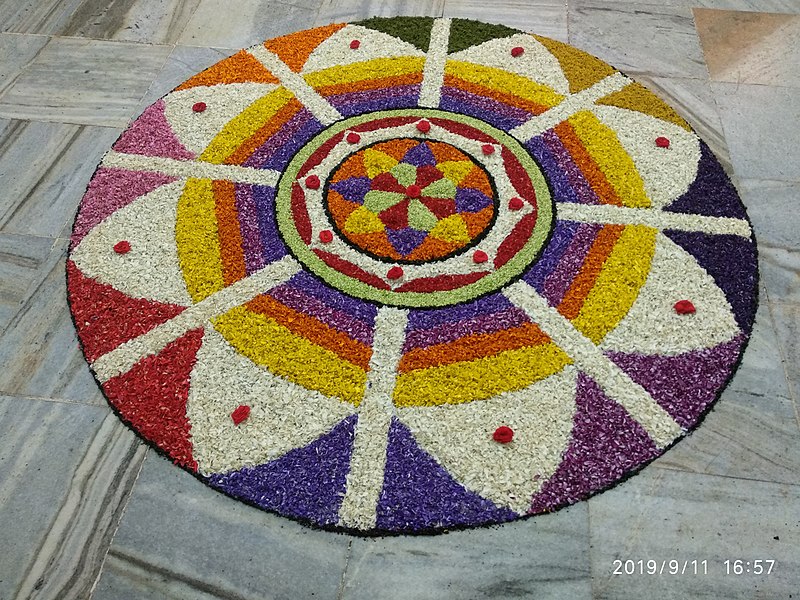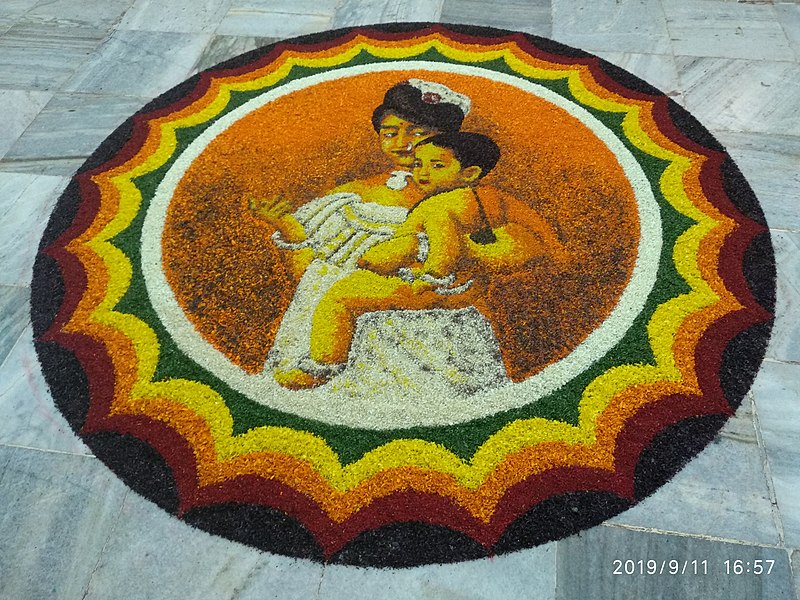Pookalam (Flower Rangoli)

Rangoli is an art form from India in which patterns (similar to mandala designs) are created on the floor in living rooms or courtyards. The materials like coloured sand, coloured rice, dry flour or flower petals are used to make Rangoli.
The purpose of rangoli is decoration, and it is thought to bring good luck. Based on the area , traditions and folklore the designs may also vary. Generally, this practice is showcased during occasions such as festivals, auspicious observances, marriage celebrations and other similar milestones and gatherings.Traditionally it is done by women. Rangoli done with flowers is called pookalam.
Step 1: Materials Needed

Many type of flowers can be used to make pookalam. You can buy flowers or use the flowers available in your home. Either the whole flower or only the petals can be used to make pookalam.
Instead of buying I collected flowers from my neighborhood.
Flowers
- Violet / Blue – Persian onion (Allium hollandicum) flower
- Green – Redwood / Bald cypress / Japanese Boxwood Leaves
- Yellow – Rose / Dandelion flower
- Orange – California Poppy flower
- Red – Rose / Geranium flower
- Dark Pink – Geranium flower
- Light Pink – Rose
Other materials
Trace paper, Scale and Pens
You can also use zinnia, mums, hydrangea, marigold, aster and chrysanthemum flowers.
Step 2: Preparation of Petals and Drawing Outline
- Separate the petals of all flowers and leaves.
- Keep it in plastic covers or cups.
Designs – Either use a chalk to draw the outline directly on the floor or draw the designs on trace paper. You can use pattern similar to mandala designs. You can choose whatever design you like based on the availability of flowers.I have drawn it in the trace paper.
Step 3: Arrange the Petals
- Start arranging petals starting from the center.
- The width can be either reduced or increased based on the availability of the petals.
- 5 circle layers are formed.
Step 4: Middle Layer
Since i had red ,light & dark pink petals, i used it in the middle layer.
Step 5: Outer Layer
I have added 3 more layers and finished it with green leaves.
Usually Brass or Silver Indian lamps are used along with the pookalam. I have added an old picture with Indian silver lamp. You can also add candles to the pookalam.
About Pookalam
The floral Rangoli, known as Onapookkalam, Athapookkalam or just Pookkalam,[46] is made out of the gathered blossoms with several varieties of flowers of differing tints pinched up into little pieces to design and decorate patterns on the floor, particularly at entrances and temple premises like a flower mat. Lamps are arranged in the middle or edges. It is a work of religious art, typically the team initiative of girls and women, who accomplish it with a delicate touch and a personal artistic sense of tone and blending.[47] When completed, a miniature pandal (umbrella) hung with little festoons is erected over it.[48] The pookkalam is similar to Rangoli which is made of powders of various colors and is popular in North India.
The traditional ritual of laying pookkalam (floral Rangoli) starts on Atham day. The pookkalam on this day is called Athapoo, and it is relatively small in size. The size of the pookkalam grows in size progressively with each day of the Onam festival. Only yellow flowers will be used on Atham with only one circular layer made and the design is kept simple. Statues or figurines of Mahabali and Vamana are also installed at the entrance of each house on this day.
Traditionally, Atthapookalams included flowers endemic to Kerala and the Dashapushpam (10-flowers), but nowadays all varieties of flowers are used. Earthen mounds, which look somewhat like square pyramids, representing Mahabali and Vamana are placed in the dung-plastered courtyards in front of the house along with the Pookalam, and beautifully decorated with flowers. All over Kerala, Pookalam competitions are a common sight on Onam day.
Instructables

PROFILE
Instructables is a a web-based documentation system allowing the community to document, and share creations.
Established in 2006, and has gone on to grow from a modest hundreds of projects to over one hundred thousand.


































